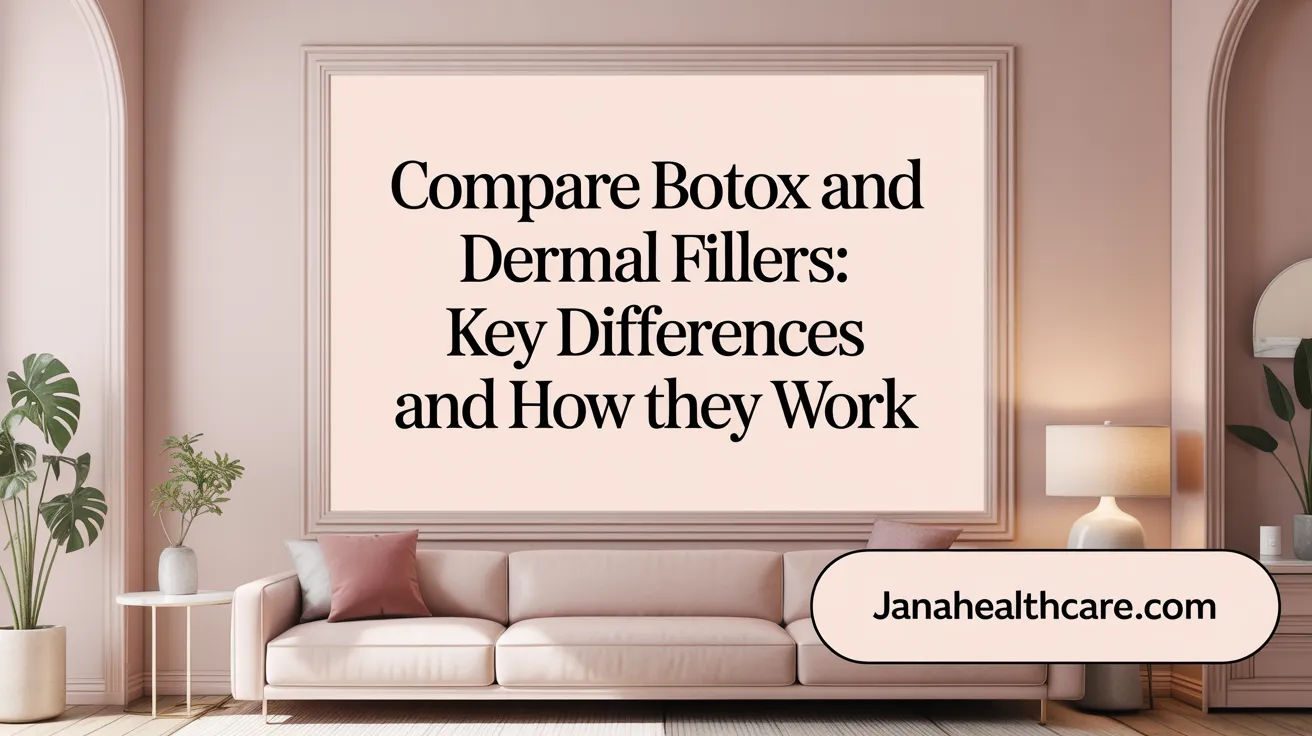Choosing the Right Facial Rejuvenation Method
In the realm of minimally invasive cosmetic procedures, Botox and dermal fillers stand out as popular options for reducing signs of aging and enhancing facial features. Each treatment offers unique benefits suited to different aesthetic concerns, making it important to understand their distinct mechanisms, uses, and results. This article explores the differences between Botox and fillers to help you decide which treatment aligns best with your skincare goals and facial anatomy.
Botox vs. Dermal Fillers: Key Differences and Mechanisms

What are the main differences between Botox and dermal fillers?
Botox and dermal fillers are widely used cosmetic treatments, but they serve different purposes due to their mechanisms. Botox is a neurotoxin derived from the bacterium Clostridium botulinum. It works by temporarily relaxing the muscles that cause wrinkles. This makes it effective for dynamic wrinkles—those that appear when muscles contract—such as frown lines, forehead lines, and crow’s feet. Typically, its effects last about 3 to 4 months (Botox results duration).
Dermal fillers consist of gel-like substances, most commonly hyaluronic acid, a molecule naturally found in the body. Fillers are used to restore lost facial volume, smooth static wrinkles, and enhance features such as lips, cheeks, and chin. Effects from fillers generally last between 6 to 12 months, depending on the type used and the area treated (Duration of filler effects).
Both treatments address different aging signs: Botox targets expression lines caused by muscle activity, while fillers combat volume loss and static creases related to aging. Often, practitioners combine both in one session for a comprehensive facial rejuvenation tailored to individual needs.
How do Botox and dermal fillers work and what are their mechanisms of action?
Botox (botulinum toxin type A) works by blocking nerve signals to specific muscles. When injected, it prevents the release of acetylcholine, a neurotransmitter responsible for muscle contraction. This inhibition causes the targeted muscles to relax, which softens the appearance of lines and wrinkles formed through repeated facial expressions.
Results typically become visible within 24 hours to two weeks after treatment, with the relaxation effect lasting approximately three to six months (Duration of Botox effects). To maintain the desired effect, repeat treatments are necessary.
Dermal fillers operate differently. They involve injecting substances like hyaluronic acid, calcium hydroxylapatite, or poly-L-lactic acid beneath the skin surface (Types of dermal fillers). These fillers physically add volume, fill in deep lines, and reshape facial contours. They directly counteract volume loss, restoring a more youthful appearance.
While Botox reduces the movement that causes wrinkles, fillers fill in areas that have sunken or lost volume due to aging or weight loss. Both treatments are minimally invasive and usually performed in outpatient settings, making them popular and convenient options for facial rejuvenation.
Uses, Indications, and Suitable Treatment Areas

What are the suitable uses and indications for Botox and dermal fillers?
Botox is mainly used to target dynamic wrinkles caused by repetitive muscle movements. These include frown lines between the eyebrows, crow’s feet around the eyes, horizontal forehead lines, bunny lines on the nose, lip flip enhancements, and even medical issues like migraines, hyperhidrosis (excessive sweating), neck spasticity, and muscle spasms. It functions by temporarily blocking nerve signals, leading to muscle relaxation. Typically, effects last about 3 to 6 months, requiring periodic treatments.
Dermal fillers serve different purposes. They are designed to restore lost volume, shape facial contours, and fill static wrinkles—those visible even when muscles are at rest. Common areas include the lips, cheeks, chin, jawline, under-eye hollows, and the back of the hands. Fillers are usually made from hyaluronic acid, calcium hydroxylapatite, or poly-L-lactic acid, with effects lasting approximately 9 to 12 months. Beyond cosmetic enhancements, fillers are also used for reconstructive purposes like scar correction and facial reshaping. Though generally safe when administered by trained professionals, they do carry risks like allergic reactions, tissue necrosis, or unintended vascular occlusion.
For which aesthetic goals and facial areas are Botox and dermal fillers most suitable?
Botox is best suited for smoothing expression lines caused by active muscle movement. It is highly effective in areas such as the forehead, glabella (between the eyebrows), crow’s feet, bunny lines, and around the mouth. It can also be used to lift drooping brows or eyelids and to relax neck muscles. Clinical use extends beyond cosmetics to medical treatments such as bruxism (teeth grinding) and muscle hyperactivity.
Fillers are ideal for restoring volume and enhancing facial features. They excel in the mid-face region—restoring cheek volume and defining cheekbones—as well as smoothing deep lines like nasolabial folds and marionette lines. They also enhance lips and help contour jawlines and chin for a more balanced profile. Many patients opt for combined treatments, where Botox addresses dynamic wrinkles and fillers correct static folds and volume loss for comprehensive facial rejuvenation.
What are the medical and cosmetic applications of Botox and dermal fillers?
Medically, Botox has a range of therapeutic uses. It treats muscle overactivity disorders such as dystonia, blepharospasm (uncontrollable blinking), strabismus (crossed eyes), and hyperhidrosis (excessive sweating). It may also alleviate migraines, overactive bladder, and spasms in various muscles. These applications work through the neurotoxin’s ability to block nerve signals, reducing muscle contractions.
Cosmetically, Botox’s primary role is to diminish the appearance of dynamic wrinkles—those caused by muscle movement—especially on the upper face. It softens forehead lines, frown lines, and crow’s feet, resulting in a more relaxed, youthful look.
For fillers, the main cosmetic goal is of volume enhancement and wrinkle filling. They address sunken cheeks, thinning lips, deep facial creases, and scars, improving overall facial harmony. Both treatments are performed via injection and require expertise for safety and optimal results. They typically last from several months up to two years, depending on product type and treatment area.
In summary, Botox is excellent for reducing expression-based wrinkles and certain medical conditions involving muscles, while fillers are mainly used to volumize and correct static signs of aging or trauma. Combined, they offer a comprehensive approach for facial rejuvenation.
Duration, Results, and Combining Treatments
 When considering injectable treatments like Botox and dermal fillers, understanding the typical duration of their effects is crucial for planning and expectations. Botox generally provides results that last about 3 to 4 months. This timeframe applies to most facial areas targeted with Botox, such as the forehead, glabellar lines, and crow’s feet. The effects gradually diminish as nerve signals to the muscles resume, requiring repeat treatments to maintain the smooth appearance.
When considering injectable treatments like Botox and dermal fillers, understanding the typical duration of their effects is crucial for planning and expectations. Botox generally provides results that last about 3 to 4 months. This timeframe applies to most facial areas targeted with Botox, such as the forehead, glabellar lines, and crow’s feet. The effects gradually diminish as nerve signals to the muscles resume, requiring repeat treatments to maintain the smooth appearance.
In contrast, dermal fillers tend to have a longer-lasting impact. The longevity of fillers varies depending on the type used and the treatment area. For example, hyaluronic acid-based fillers like JUVEDERM Voluma, used for cheek augmentation, can last between 12 to 18 months. Fillers like JUVEDERM Volbella, suitable for delicate areas under the eyes, typically last up to 12 months. Lip fillers generally maintain their results for 6 to 12 months, while deeper filler treatments like those for nasolabial folds can last between 9 and 18 months.
The onset of results also differs. Botox effects are not immediate; it usually takes about 3 to 7 days for the full effect to appear, with optimal results visible around two weeks. Dermal fillers, on the other hand, deliver near-instant results, with improvements seen immediately after treatment. This quick response makes fillers a popular choice for those seeking rapid facial enhancement.
Many patients benefit from combining Botox and fillers in one session. This approach allows addressing multiple signs of aging simultaneously: Botox relaxes muscles to reduce dynamic wrinkles, while fillers restore volume and shape, smoothing static lines and enhancing facial contours. The combined treatment can produce a natural, refreshed look and may reduce the frequency of maintenance sessions since each addresses different concerns.
Typical treatment and recovery times are also brief. Both Botox and fillers are minimally invasive outpatient procedures that usually take between 15 to 45 minutes. Recovery is rapid, with most patients able to return to normal activities immediately. Mild side effects such as swelling or bruising may occur temporarily but generally resolve within a few days.
In summary, Botox offers a shorter duration of around 3 months, while dermal fillers can last from 6 months to 2 years. Combining these treatments can optimize results and extend the overall period of facial rejuvenation. Consulting with a qualified healthcare professional can help tailor the right combination based on individual needs and aesthetic goals.
Safety, Side Effects, and Potential Complications

What are the common side effects and potential complications associated with Botox and dermal fillers?
Common side effects of Botox typically include bruising, swelling, redness, pain at the injection site, and short-term effects such as headache or eyelid drooping, known as ptosis. Some individuals might experience temporary facial asymmetry or mild flu-like symptoms. Serious complications, though rare, can entail unintended muscle weakness beyond the targeted area, difficulty swallowing or breathing, and the spread of the toxin causing symptoms similar to botulism. Learn more about Botox side effects and Botulinum toxin safety and effectiveness.
For dermal fillers, common reactions involve swelling, bruising, lumps, redness, tenderness, and sometimes mild pain at the site of injection. More severe but infrequent risks include vascular occlusion, where a blood vessel is blocked, potentially leading to tissue necrosis, blindness, stroke, or even permanent tissue damage if the filler accidentally enters a blood vessel. For detailed safety information see Dermal filler dos and don'ts and Fillers safety and side effects.
Overall, both treatments are considered very safe when performed by experienced, licensed professionals. Serious adverse effects are uncommon but can occur and necessitate prompt medical intervention. Additional details are available in Botox vs. Fillers: safety considerations and Dermal Fillers Overview and Safety.
Why is the qualification of the provider important?
Administering Botox and dermal fillers requires precise technique and thorough knowledge of facial anatomy. Qualified healthcare providers such as board-certified dermatologists or plastic surgeons are trained to minimize risks, properly assess individual conditions, and react swiftly if complications arise. Choosing an unqualified or inexperienced person significantly increases the likelihood of undesirable side effects and serious health issues. Read more about Licensed healthcare providers for injectables and the Importance of choosing a qualified practitioner.
Post-treatment care and precautions
After treatment, patients should follow their provider’s instructions, which often include avoiding vigorous facial movements, heavy exercise, alcohol, and makeup application for at least 24 hours. Applying ice packs can reduce swelling and bruising. Patients are advised to stay upright for several hours post-injection and report any unexpected symptoms such as intense pain, vision changes, or signs of infection immediately. Regular follow-up visits help ensure the best results and monitor for any delayed reactions. For guidance on post-treatment care and precautions, see Post-treatment care after Botox and fillers and Managing filler complications and care.
Types of Dermal Fillers and Cost Considerations

Varieties of dermal fillers and their ingredients
There are several types of cosmetic fillers available, each containing different ingredients suited to specific aesthetic goals. Hyaluronic acid (HA) is the most common, providing a soft, gel-like consistency that adds volume and smooths wrinkles, with brands like Juvederm and Restylane. Calcium hydroxylapatite (CaHA), found in Radiesse, is a thicker, longer-lasting mineral-based filler that stimulates collagen production. Poly-L-lactic acid (PLLA), such as Sculptra, is a collagen stimulator that gradually rebuilds facial volume over time, with effects lasting over two years. Polymethylmethacrylate (PMMA) microspheres, like Bellafill, are semi-permanent fillers offering long-term support. Additionally, autologous fat injections involve harvesting and reinjecting a patient's own fat for natural, lasting results (Injectable dermal fillers overview).
Temporary vs. semi-permanent fillers
Most dermal fillers are temporary, gradually breaking down and being absorbed by the body over months (typically 6–12 months for HA-based fillers) or up to a few years for some types like PLLA or PMMA. Semi-permanent options, like Bellafill, contain microspheres that can last several years but may require more careful consideration due to their long-lasting nature. The choice between temporary and semi-permanent fillers depends on patient goals, desired longevity, and risk tolerance (Pros and Cons of Dermal Fillers).
Average costs for Botox and fillers
The cost of Botox treatments generally ranges from approximately $300 to $600 per session. Since Botox's effects last about 3 to 4 months, repeated treatments are necessary for ongoing results. In comparison, dermal fillers cost between $684 and $1,058 per syringe, with effects lasting from 6 months up to several years depending on the type (Botox and dermal fillers cost comparison).
Cost-effectiveness over time
While Botox may seem more affordable per session, its frequent repeat treatments can add up over years. Fillers, although more expensive initially, provide longer-lasting results, potentially making them more cost-effective for volume restoration and correction. Patients should consider their aesthetic goals, the longevity of the results, and their budget when choosing between these options (Botox vs Fillers cost-effectiveness).
Importance of choosing experienced providers
Regardless of the treatment type, selecting a qualified, experienced healthcare professional is crucial. Skilled providers ensure proper injection techniques, reduce risks of complications like uneven results or vascular injury, and help achieve natural-looking outcomes. Proper training and a thorough consultation are essential to maximize safety and satisfaction (Dermal filler dos and don'ts).
Making the Best Choice for Your Facial Aesthetics
Choosing between Botox and dermal fillers involves understanding their distinct functions, indications, and outcomes. Botox excels in smoothing dynamic wrinkles by relaxing facial muscles, while dermal fillers restore lost volume and improve facial contours. Both treatments offer safe, minimally invasive options with varying durations, side effects, and costs. Consulting with experienced, qualified professionals will ensure treatments align with your individual needs and aesthetic goals, potentially combining both methods for a natural, youthful appearance.
